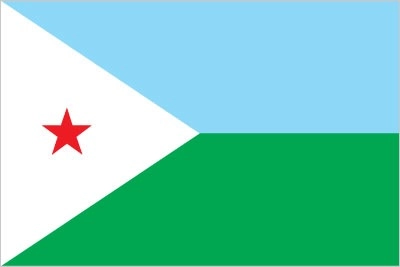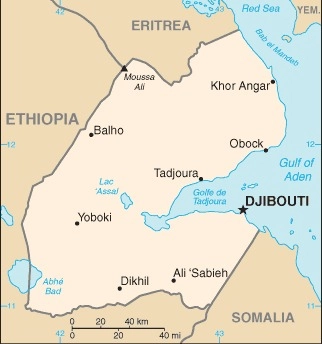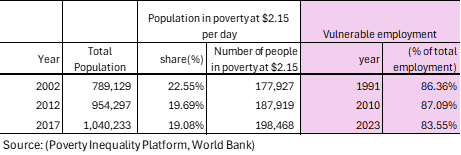
Djibouti
Country Flag Details
two equal horizontal bands of light blue (top) and light green with a white isosceles triangle based on the hoist side bearing a red five-pointed star in the center; blue stands for sea and sky and the Issa Somali people; green symbolizes earth and the Afar people; white represents peace; the red star recalls the struggle for independence and stands for unity.
Background
The French Territory of the Afars and the Issas became Djibouti in 1977. The government has longstanding ties to France, which maintains a military presence in the country, as do the US, Japan, Italy, Germany, Spain, and China.

Geography
Area
total : 23,200 sq km
land: 23,180 sq km
water: 20 sq km
Climate
desert; torrid, dry
Natural resources
potential geothermal power, gold, clay, granite, limestone, marble, salt, diatomite, gypsum, pumice, petroleum
People and Society
Population
total: 994,974
Ethnic groups
Somali 60%, Afar 35%, other 5% (mostly Yemeni Arab, also French, Ethiopian, and Italian)
Languages
French (official), Arabic (official), Somali, Afar
Religions
Sunni Muslim 94% (nearly all Djiboutians), other 6% (mainly foreign-born residents – Shia Muslim, Christian, Hindu, Jewish, Baha’i, and atheist)
Population growth rate
1.89% (2024 est.)
Government
Government type
presidential republic
Capital name: Djibouti
Executive branch
chief of state: President Ismail Omar GUELLEH (since 8 May 1999)
head of government: Prime Minister Abdoulkader Kamil MOHAMED (since 1 April 2013)
Economy
Economic overview
food import-dependent Horn of Africa economy driven by various national military bases and port-based trade; fairly resilient from COVID-19 disruptions; major re-exporter; increasing Ethiopian and Chinese trade relations; investing in infrastructure
Real GDP (purchasing power parity)
$7.38 billion (2023 est.)
$6.918 billion (2022 est.)
$6.669 billion (2021 est.)
Real GDP per capita
$6,400 (2023 est.)
$6,100 (2022 est.)
$5,900 (2021 est.)
Exports
$5.877 billion (2023 est.)
$5.674 billion (2022 est.)
$5.16 billion (2021 est.)
Exports – partners
Ethiopia 77%, UAE 5%, China 3%, Singapore 2%, France 2% (2023)
Exports – commodities
raw sugar, seed oils, cars, palm oil, rice (2023)
Imports
$5.269 billion (2023 est.)
$5.096 billion (2022 est.)
$5.483 billion (2021 est.)
Imports – partners
China 32%, India 12%, UAE 10%, Turkey 6%, Morocco 5% (2023)
Imports – commodities
refined petroleum, palm oil, fertilizers, cars, seed oils (2023)

Export structure by product group in 2023 (% of total exports) (UNCTAD)
The export structure of a nation provides a detailed reflection of the variety, composition, and economic significance of the goods and services it exchanges on the global marketplace, serving as a vital indicator of the country’s economic health, competitive stance, and developmental progress. In the case of Djibouti, the export framework is heavily dependent on a narrow range of essential commodities, primarily targeting the Ethiopian market. This reliance has profound implications for the nation’s economic stability and prospects for future growth. While the lack of diversification inherently introduces certain risks that could threaten economic resilience, it simultaneously unveils potential opportunities for strategic developments in other sectors, paving the way for enhanced stability and a more robust response to external economic challenges.

Poverty and vulnerable employment in Djibouti
In 2023, 84 percent of Djibouti’s total employment was identified as living in poverty at an income threshold of $2.15 per day. Vulnerable employment refers to work that is marked by insufficient job security, meager wages, and a lack of essential social protections such as health insurance, pensions, or labor rights. This category typically encompasses Own-Account Workers who are self-employed without any employees, like street vendors and small-scale farmers, as well as Contributing Family Workers who assist in family-owned businesses or farms without formal compensation. These roles are often informal and unstable, devoid of benefits, which leaves workers particularly vulnerable to economic shocks, exploitation, and poverty. The repercussions of this type of employment reach beyond the individual, affecting families and communities, and can perpetuate cycles of instability and hardship that are difficult to escape.
Undserstanding poverty level significance at $2.15 per day
In 2017, 19 percent of Djibouti’s population was identified as living in poverty at an income threshold of $ 2.15 per day. The poverty level at $2.15 per day (measured in 2017 purchasing power parity, or PPP) is a key global benchmark used by the World Bank to define extreme poverty in low-income countries. It indicates:
1. Basic Survival Threshold
• People living below $2.15 per day struggle to afford essential needs such as food, clean water, shelter, healthcare, and education.
2. Economic Underdevelopment
• A high percentage of a country’s population living below this threshold suggests low economic productivity, high unemployment, and weak social safety nets.
3. Inequality and Social Vulnerability
• It reflects deep income inequality and a lack of access to opportunities for upward mobility.
• People in this category are more vulnerable to shocks like food price increases, climate disasters, or health crises.
4. Policy Challenges
• Governments need targeted interventions such as social welfare programs, job creation, and improved access to education and healthcare to reduce poverty.
A country's export structure is a reflection of its level of development and productive capacities
The export structure of a country refers to the composition, diversity, and value of the goods and services it sells to other countries. It provides key insights into the country’s economic health, competitiveness, and level of development. Productive capacities of a country refer to its ability to produce goods and services efficiently and sustainably over time. These capacities are shaped by various factors, including human capital, natural resources, infrastructure, private sector, development, technology & innovation, institutions & governance, financial systems trade & market access.
Here’s what the export structure and productive capacities of a country typically indicate:
- Level of Economic Development
- Developed economies usually export high-value manufactured goods, technology, and services.
- Developing economies often rely on raw materials, agricultural products, or low-value manufactured goods.
- Industrial and Sectoral Strengths
- A strong presence of high-tech or industrial goods (e.g., machinery, electronics) suggests a well-developed manufacturing sector.
- A dominance of commodities (e.g., oil, minerals, agricultural products) indicates reliance on natural resources.
- Export Diversification
- A diverse export base (multiple industries) makes a country’s economy more stable and resilient to global price shocks.
- A concentrated export base (few key products) makes it vulnerable to market fluctuations.
- Trade Partnerships and Dependence
- If exports are heavily dependent on a single country or region, the economy is more exposed to geopolitical and trade risks.
- A wide range of trading partners indicates stronger global integration.
- Competitiveness and Value Addition
- Exporting mainly raw materials (e.g., crude oil instead of refined petroleum) suggests limited industrial processing capacity.
- A high share of finished and high-tech goods suggests strong value addition and competitiveness.
Djibouti-Sanitation
Djibouti – Proportion of population served with at least basic sanitation
In 2022, proportion of population served with at least basic sanitation for Djibouti was 66.9 %. The proportion of population served with at least basic sanitation of Djibouti increased from 47.1 % in 2003 to 66.9 % in 2022, an absolute change of 19.8 percentage points (pp) between 2003 and 2022.
Djibouti – Proportion of urban population served with at least basic sanitation
In 2022, proportion of urban population served with at least basic sanitation for Djibouti was 79.3 %. Proportion of urban population served with at least basic sanitation of Djibouti increased from 57.9 % in 2003 to 79.3 % in 2022 an absolute change of 21.4 pp between 2003 and 2022.
Djibouti – Proportion of rural population served with at least basic sanitation
In 2022, proportion of rural population served with at least basic sanitation for Djibouti was 21.9 %. Proportion of rural population served with at least basic sanitation of Djibouti increased from 11.5 % in 2003 to 21.9 % in 2022 an absolute change of 10.5 pp between 2003 and 2022.
Djibouti- Proportion of population served with at least basic sanitation: A Global Perspective
The ongoing lack of safe sanitation represents a profound and critical challenge that necessitates immediate and united action, leading to preventable deaths for hundreds of thousands of individuals each year and highlighting a major public health crisis that requires our focus. Access to safe sanitation is not merely a necessity; it is a fundamental human right that should be guaranteed to everyone without exception. In 2022, 23 percent of Djibouti’s population faced severe consequences from inadequate sanitation facilities, a situation that starkly contrasts with the experiences of other nations. For instance, Vietnam, China, and Thailand reported significantly lower percentages of their populations lacking these essential services, with only 8 percent, 5 percent, and 1 percent respectively. Furthermore, the global average of individuals without access to proper sanitation is approximately 6 percent, underscoring the urgent need for collaborative efforts to enhance sanitation access in the underserved and vulnerable regions of Sub-Saharan Africa. The persistent absence of safe sanitation not only jeopardizes health and safety but also hampers the potential for social and economic development, making it imperative that we prioritize this issue to ensure a healthier future for all.
Djibouti – Proportion of rural population not served with at least basic sanitation: A Global Perspective
Djibouti is currently grappling with a profound crisis that severely undermines the dignity and overall well-being of its people, as a staggering 78 percent of its rural population finds itself without access to even the most basic sanitation facilities. This distressing reality stands in stark contrast to nations such as Vietnam, Sri Lanka, and Thailand, where these figures are significantly lower at merely 12 percent, 5 percent, and 2 percent respectively. The pervasive lack of safe sanitation is not just an urgent issue; it constitutes a tragic humanitarian crisis that demands our immediate and unwavering attention, leading to the preventable loss of countless lives each year while exacerbating a public health emergency that urgently requires our compassionate and decisive action. Access to safe sanitation is not merely a basic necessity; it is an essential human right that every individual is inherently entitled to and deserves. Therefore, it is crucial that we come together, as a global community, to advocate for this fundamental right throughout Sub-Saharan Africa, where the stakes are extraordinarily high and the potential for meaningful community change is vital in safeguarding the health, dignity, and future of every individual.
Djibouti-Water Supply
Djibouti – Proportion of total population served with at least basic water
In 2022, proportion of population served with at least basic water for Djibouti was 76.2 %. Between 2003 and 2022, proportion of population served with at least basic water of Djibouti grew substantially from 75.5 to 76.2 % an absolute change of 0.7pp between 2003 and 2022.
Djibouti – Proportion of urban population served with at least basic water
In 2022, proportion of urban population served with at least basic water for Djibouti was 84.1 %. Proportion of urban population served with at least basic water of Djibouti increased from 82.3 % in 2003 to 84.1 % in 2022 an absolute change of 1.8 pp between 2003 and 2022.
Djibouti – Proportion of rural population with at least basic water
In 2022, proportion of rural population served with at least basic water for Djibouti was 47.3 %. Between 2003 and 2022, proportion of rural population served with at least basic water of Djibouti was declining, from 53.2 % in 2003 to 47.3 % in 2022, an absolute change of 5.9 pp between 2003 and 2022.
Djibouti- Proportion of population served with at least basic drinking water: A Global Perspective
Djibouti’s struggle for access to safe drinking water not only highlights a pressing humanitarian crisis but also reflects a profound moral imperative that necessitates immediate global response and solidarity. In 2022, around 24 percent of Djibouti’s population found themselves without this essential resource, emphasizing a dire public health emergency that challenges our collective responsibility to take decisive action. Conversely, in that same year, every person in Thailand, along with an impressive 98 percent of populations in Vietnam and Bangladesh, had reliable access to safe drinking water, starkly revealing the alarming disparities that demand significant reforms in Sub-Saharan Africa. This region continues to grapple with unique and multifaceted challenges, as a considerable number of individuals lack the fundamental resources required to elevate their standard of living. It is crucial that we intensify our efforts to narrow this gap and ensure that every individual has access to safe drinking water, as this issue transcends mere convenience and embodies a fundamental ethical duty we owe to each other as a united global community.
Djibouti- Proportion of rural population not served with at least basic drinking water: A Global Perspective
In 2022, it is a matter of profound concern that a staggering 53 percent of the rural population in Djibouti remained without access to safe drinking water facilities, illuminating a dire humanitarian crisis that urgently calls for immediate intervention from the global community. This situation starkly contrasts with the impressive advancements made by nations like Thailand, Bangladesh, and Vietnam, where nearly universal access to this vital resource has been achieved, with 100 percent, 98 percent, and 97 percent of their rural citizens respectively enjoying the benefits of safe drinking water. Such glaring inequality does not merely highlight the considerable governance challenges that confront numerous Sub-Saharan African countries but also accentuates the pressing need for coordinated efforts and collective action aimed at enhancing living conditions across the region. It is crucial that we direct our attention toward ensuring that marginalized communities, who suffer the most from these disparities, receive the essential resources they desperately require to not only survive but also to thrive in a world where access to clean water is a fundamental human right.
Djibouti-Health outcomes
Djibouti-Life expectancy: A Global Perspective
In 2022, life expectancy in Djibouti reached 62.9 years, a significant step forward from just 49.1 years in 1973. This increase is a reflection of the global advancements in health that have propelled many nations toward greater longevity, with the average life expectancy for newborns worldwide soaring from 47 years in 1950 to an impressive 71 years by 2021. Despite this overall progress, regions in Sub-Saharan Africa, including Djibouti, have seen more limited gains in health outcomes. The stark disparities become evident when comparing Djibouti’s situation with that of South Korea, which experienced a remarkable rise in life expectancy from 54 years in 1960 to a noteworthy 83 years in 2022, and the Maldives, where life expectancy climbed from 39 years in 1960 to 81 years in 2022. These contrasting figures underscore the persistent challenges faced in achieving equitable health outcomes across Sub-Saharan Africa, highlighting the need for continued efforts to address these inequalities.
Djibouti- Under-5 mortality rate (per 1000 live births): A Global Perspective
In 2022, the under-5 mortality rate for Djibouti was 51.9 deaths per thousand live births, reflecting a steady decline from a concerning 92.8 deaths per thousand in 2003. This statistic underscores the persistent challenges that families encounter in a context where global child mortality rates have decreased markedly since 1950, largely attributed to advancements in living standards, healthcare, nutrition, and access to clean drinking water. While wealthier nations in Europe and America have successfully reduced their rates to below 4 percent, many developing countries across South America, Asia, and Africa have made significant progress over the past seven decades, although several Sub-Saharan African nations have experienced slow advancements. For instance, Djibouti’s rate sharply contrasts with the considerably lower rates reported by South Korea, Thailand, Sri Lanka, and Vietnam, which recorded 3, 8, 7, and 20 deaths per thousand live births in 2022, respectively. Despite a remarkable global decline in child mortality from 22.7 percent in 1950 to 3.6 percent in 2023, the imperative to ensure that every child has the opportunity for a healthy life remains a critical and compassionate goal that necessitates our collective commitment.
Djibouti- Maternal mortality ratio(per 1000,000 live births): A Global Perspective
In 2020, Djibouti recorded a maternal mortality ratio of 234 deaths per 100,000 live births, which signifies a noteworthy yet gradual drop from 487 deaths per 100,000 live births in 2000. This statistic casts a stark light on the enduring challenges that women in Sub-Saharan Africa continue to encounter, where high birth rates alongside alarmingly elevated maternal mortality rates pose a significant threat to maternal health. While progress is evident in other parts of the world, such as Bangladesh, which successfully reduced maternal deaths from 441 in 2000 to just 123 in 2020, and India’s impressive decrease from 384 in 2000 to 103 in 2020, Djibouti’s maternal mortality ratio remains troublingly high at 234 deaths per 100,000 live births. This figure serves as a striking contrast to the remarkably lower rates observed in South Korea and China, which reported maternal mortality ratios of 8 and 23 deaths per 100,000 live births, respectively. Such disparities underscore the pressing need for compassionate and comprehensive healthcare reforms across Sub-Saharan Africa to ensure that every woman is afforded the opportunity for a safe and healthy pregnancy, reflecting a fundamental human right that must be prioritized.